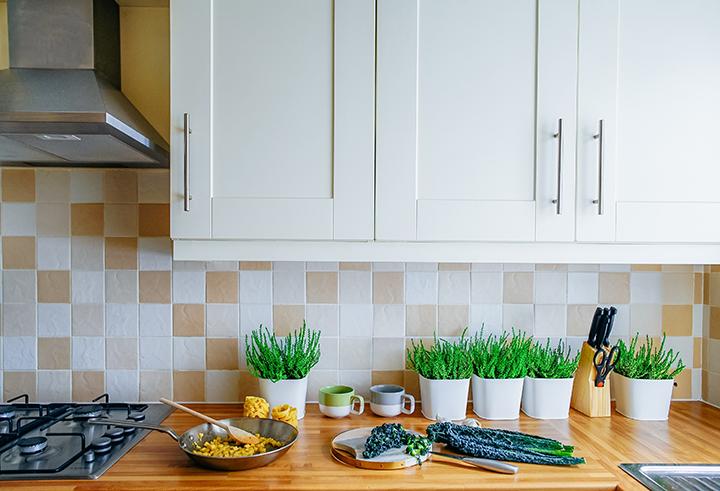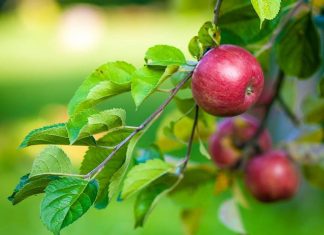| Issue #97 • January/February, 2006 |
The freeway en route to home resembles a parking lot, allowing you plenty of time to add up all of the tasks awaiting you once you walk in your front door. Let’s see, there’s an Everest size mountain of laundry starting to lend its perfume to the house, soccer practice for your son, your daughter’s diorama book report due tomorrow, the bathrooms are screaming out for a bottle of cleanser, and that age old question, “What’s for dinner?”
Why not put the kids to work and get them involved in the cooking process? The list of benefits are endless. Not only does it help you put a dent in the daily list of chores, but it teaches children the importance of learning to cook in the modern structure of today’s lifestyle, when more and more people seek the fast-food joint around the corner or pick up the phone to order take-out. The U.S. Department of Labor indicates that 26.2% of single parents’ food budget is dedicated to meals away from home. “Kids start expressing their interest in cooking at toddler age. This is a great time to nurture this interest. Often parents don’t want the mess, but they can spend quality time with their children while they learn to cook. Down the line, parents are going to have good little helpers,” says Elaine Magee, MPH, RD and author of many cooking books, including Someone’s in the Kitchen with Mommy.

Throwing a junior apron and chef hat on your children allows them to explore the creativity found in the confines of the kitchen and introduces lifelong concepts of healthful eating patterns. By getting them into the habit of eating traditional meals that include foods from the major food groups, children need not rely on French fries and chicken fingers to fill their bellies. Child obesity is on the rise, with the National Center for Health Statistics reporting that 15% of children ages 6-19 are overweight compared with only 6% in 1976-1980. The Department of Agriculture’s Center for Nutrition Policy and Promotion indicates that approximately 80% of children ages 4-9 consume diets that are classified as “poor” or “needs improvement.”
When kids start cooking, there is an added bonus that they tend to actually eat what they prepare since they have a vested interest in confirming the fruits of their own labor. So you might be surprised to see them chomping on a vegetable pizza with gusto or digging into their own tossed salad with pleasure. With all of the stress of managing a family, good nutrition for the entire family is an important tool in keeping the body and mind stoked.
While Elaine Magee teaches children’s cooking programs, she finds that many kids aren’t getting the opportunity to cook at home. “I find that kids love to cook and that boys are just as excited, if not more so, than girls. They’re not doing it at home. It’s an untapped resource for busy parents,” Magee says.
The benefits of spending 30 minutes around a home-cooked meal at the dinner table with the family are priceless. Children who regularly eat family meals have healthier eating habits that last a lifetime. And those precious minutes around the dining room table may be the only ones available to talk about the minutia of daily life that is so important in bracing your family in a chaotic world. A study conducted by the National Center of Addiction and Substance Abuse at Columbia University showed that the more often teens eat dinner with their family, the less likely they will smoke, drink, or use illegal drugs.
Here are some helpful tips for getting your budding chef into your kitchen.
In on the planning: Start with the basics by purchasing some children’s cookbooks, visiting children’s cooking websites, watching kids’ cooking shows, or enrolling your child in a children’s cooking program. Plenty of resources abound for young foodies. Even The Culinary Institute of America hosts a children’s cooking program these days. Then you can let your child sit down and write out a weekly menu and shopping list, a fun Sunday afternoon chore. Let them pound the aisles of the grocery store, checking items off the grocery list. Now the week ahead won’t look so dreary, with thoughts of English muffin pizza and vegetable soup on Monday night.
Cleanliness is a virtue: Along with cooking comes the less fun chore of cleaning, so get your child into the clean up act as well, from washing hands before the cooking process begins to scrubbing up the pots and pans afterward. Give your child a lesson on basic food sanitation. Start with an explanation that bacteria from hands, nose, and mouth can be transferred into food, and when it’s left out at room temperature too long the bacteria can multiply, causing food-borne illness. Teach them how to get dishes, appliances, and counter tops squeaky clean.
Think safety: For children, the kitchen can be a dangerous place. There are plenty of opportunities for cuts, burns, shocks, and falls in this room where sharp things, electrical plugs, flames, and wet floors live. Younger children may not be ready to wield knives, but pizza wheels, egg slicers, enclosed choppers, plastic disposable knives, and blunt scissors may do the trick of cutting for them more safely. Likewise, you may want to instruct your child to let you open the oven door and stir the hot pot depending on the child’s age. Teach them about safety as you go, pointing out that the stove burners may be hot even when they are turned off and that steam escapes boiling pots when lids are removed. Be sure to point all pot handles inward to avoid energetic elbows from bumping into pots and spilling the hot contents onto young chefs in training. Join in with the cooking fun by supervising and teaching them until you are confident about their newfound skills.
Pack it up: Why constrain your child to the dinner menu? Let them come up with crazy lunchbox concoctions to pack up the night before. Try out homemade granola snack mixes, banana bread, macaroni and cheese in a thermos, quesadillas, and more to beat the lunch box blues.
Dinnertime nutrition lessons: Post a copy of the food guide pyramid (www.usda.gov/cnpp/pyrabklt.pdf) on your frig and point out what foods your meal will represent on the chart. Locate the vegetables in the soup, the cheese in the pasta, and the milk in the yogurt on the chart. Try to make sure dinner provides a fruit/vegetable serving, protein serving, starch/cereal/bread serving, and a milk product serving each night. Teach your child all about food; facts like carrots are good for your eyes, and potatoes grow under the ground.
Creativity in the making: Let your child’s creative spirit soar in the kitchen. Let him select colors from the vegetable bin like he chooses crayons from the crayola box to paint your dinner menu with all the shades of the rainbow. If julienne strips make her giggle, then go for it. Let her turn a broccoli spear into a tree, an orange slice into a happy face. Does he want to shape the grilled cheese sandwiches into race cars? Hand him the appropriate cookie cutter and let him speed.
Start out slow: If your child is too young or uncoordinated to master difficult cooking tasks, start out slow. Hand him a wooden spoon and ask him to stir the cornbread batter. Let her fetch ingredients, gather bowls, measure ingredients, or watch the timer. Add more advanced cooking tasks as their skill improves.
Culinary skills in the making: The kitchen is a classroom, so educate your child in the fine art of cooking. Start by letting him read the recipes and explain cooking terms like sauté, whip, peel, dice, and mince as you go. Show him the difference between cooking tools and appliances, from the purpose of a garlic press, to the operation of a potato masher.
Patience is another virtue: Remember, at the beginning it’s probably easier to do the cooking yourself and kids tend to spill and behave like the untrained food service workers that they are. The end results of their food products may not appeal to you, but offer plenty of encouragement and take a deep breath when they drop the flour canister. They will eventually master their tasks.
Praise the chef: Don’t be stingy with compliments. As you sit down to enjoy those precious 30 minutes, remember to tell your young culinary star how savory the green beans are and how delectable the peach cobbler is. Your child will appreciate the boost in self-esteem more than you can imagine.
Here are some favorite recipes:
Penne pasta with basil sundried tomato sauce and Romano cheese:
This popular pasta dish for kids features a light, fresh tomato sauce that’s barely there. Make sure to let your kids take a deep whiff of the fresh basil while they are chopping it.
1-½ pounds penne pasta, dried
1/3 c. olive oil
2 garlic cloves, minced
½ tsp. salt
½ tsp. black pepper
½ cup chopped fresh basil
3 ripe tomatoes, chopped finely
4 oz. Romano cheese
Cook pasta in boiling water until just tender. Meanwhile, heat olive oil in saucepan. Add garlic, salt, and pepper and sauté. Add basil and fresh tomatoes and set aside. When pasta is done, drain thoroughly and toss together with olive oil, basil, and fresh tomato mixture. Using cheese slicer, slice slivers of Romano Cheese onto each serving. Yield: 10 servings.
Parmesan garlic bread:
This easy, fun-to-assemble garlic bread will become your child’s favorite mealtime accompaniment.
1 large loaf French bread
1/3 cup margarine
1 clove fresh garlic, minced
½ cup grated Parmesan cheese
Slice French bread into thick slices. Mix margarine and minced garlic. Spread bread with garlic butter, and then sprinkle with Parmesan cheese. Place slices together into loaf form. Cover with foil and bake at 400° F for 10-15 minutes until warm and toasted. Yield: 10-12 servings.
Granny’s sunflower apple salad:
This tart, crunchy salad is high in fiber and flavor, starring all-time kids’ favorites, apples and sunflower seeds.
2 granny smith apples, washed and cubed (leave on skins)
½ cup sunflower seeds
1 small head romaine lettuce, rinsed, dried and chopped
1 dill pickle, diced
2 tomatoes, diced
½ cup sliced cucumber
½ cup light ranch dressing
In a large salad bowl, mix apples, sunflower seeds, lettuce, pickles, tomato, and sliced cucumber. Toss in ranch dressing. Serve immediately. Makes 10 servings.
Kaleidoscope fresh fruit trifle:
Kids will love layering fluffy cream, angel food cake, and colorful fruits in this tasty dessert.
12 oz. light whipped topping, thawed
8 oz. light sour cream
3.4 oz. instant vanilla pudding mix
9” angel food cake
3 kiwis, peeled and sliced
2 cups fresh strawberries, sliced
3 bananas, peeled and sliced
15 oz. can crushed pineapple, drained
In a medium bowl, fold together whipped topping, sour cream, and pudding mix. Chop the cake into large cubes. In a large trifle bowl or glass serving dish, line 1/3 of the chopped fruit. Place 1/3 cake cubes next. Then spread a layer of 1/3 of the whipped topping mix. Repeat layers twice more, using 1/3 of fruit, cake cubes, and whipped topping mix. Reserve some fruit for a garnish. Chill until serving. Makes: 12 servings.
Sharon Palmer is a registered dietitian, freelance writer, children’s culinary instructor, and mother of two in southern California.














